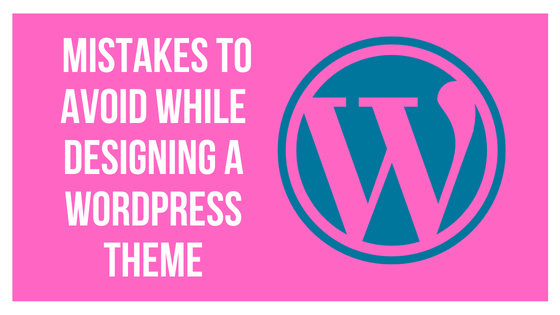WordPress is one of the most popular site-building and content management systems in use today. It powers millions of sites, from small personal blogs to large corporate sites. And it’s not hard to see why: WordPress is easy to use, has a ton of features, and is relatively inexpensive. Creating a WordPress theme can be a great way to make money or showcase your design skills. But there are a few common mistakes that many designers make when creating WordPress themes. In this article, we’ll show you four of those mistakes and how to avoid them.
Not considering your audience
When designing a WordPress theme, it’s important to consider who will be using the theme and what their needs are. Unfortunately, manyTheme designers make the mistake of not considering their audience, which can lead to a lot of problems down the road.
Without considering your audience, you run the risk of creating a theme that is either too difficult for some users to understand or too limited in functionality. Additionally, your theme may not be compatible with all of the plugins that your audience wants to use. By not considering your audience, you’re essentially shooting yourself in the foot and making it more difficult for your theme to be successful.
Not having a clear focus
One of the most common mistakes when designing a WordPress theme is not having a clear focus. It’s easy to get caught up in the design process and lose sight of what your theme is supposed to accomplish.
Your WordPress theme should have a specific purpose and target audience. Ask yourself who will be using your theme and what they need from it. Once you know that, you can start making decisions about features, colors, and layout.
If you don’t have a clear focus for your WordPress theme, it will be harder to create a successful design. Take the time to plan out your theme before you start creating it, so you can avoid this mistake.
Not keeping it simple
1. Not keeping it simple: WordPress themes are not the place to show off your design skills or get creative with your layouts. Stick to a simple, clean design that will be easy for users to navigate and read. Overly complex designs can be confusing and frustrating for users, which will ultimately reflect poorly on your brand.
2. Not paying attention to detail: In the world of web design, the details matter. Be sure to proofread your theme before you launch it, and check for any broken links or errors in your code. Little things like this can make a big difference in the user experience.
3. Not responsive: With more and more people accessing the web from mobile devices, it’s important to make sure your WordPress theme is responsive. This means that it should adjust to fit any screen size, whether it’s a desktop computer, a tablet, or a smartphone. If your theme isn’t responsive, you risk turning away potential visitors who may never come back.
4. Not considering SEO: Search engine optimization is an important part of any website, and that includes WordPress themes. Make sure your theme includes proper tags and keywords so that search engines can easily find and index your site. Without SEO, your site may never be seen by the people who are looking for what you have to offer.
5. Not staying up to date: Technology changes quickly, and WordPress is no exception. Be sure to keep your WordPress theme up to date with
Not making it mobile friendly
If your WordPress theme isn’t mobile friendly, you’re missing out on a huge portion of the market. In 2018, over 52% of internet traffic came from mobile devices, and that number is only going to grow. A mobile-friendly site is essential for keeping users engaged and ensuring they have a positive experience with your brand.
There are a few key things to keep in mind when making your WordPress theme mobile friendly:
1. Use a responsive design: This means that your site will automatically adjust to fit the screen size of whatever device it’s being viewed on. This is crucial for providing an optimal experience for all users.
2. Keep your layout simple: Too much clutter can be overwhelming on a small screen. Stick to the essentials and make sure everything is easy to find.
3. Use large, easily readable fonts: Mobile users are often on the go and may not have time to squint at tiny text. Make sure your content is easy to read by using large, legible fonts.
4. Optimize images for mobile: Images that are too large or poorly compressed can take forever to load on a mobile device. Make sure your images are properly sized and formatted for fast loading times.
5. Avoid flash: Flash doesn’t work on most mobile devices, so avoid using it in your theme altogether. If you must use it, provide an alternative version that doesn’t rely on flash for those users who can’t view it
How to choose the right WordPress theme
When it comes to WordPress themes, there is no shortage of choices. With so many options available, it can be tough to know which theme is the right fit for your website. Here are a few things to keep in mind when choosing a WordPress theme:
1. Consider your audience. Who will be visiting your website? What kind of information are they looking for? Choose a theme that is geared towards your target audience.
2. Think about the purpose of your website. What do you want your website to achieve? Choose a theme that supports your goals and helps you accomplish them.
3. Take into account the overall design of your website. How do you want your website to look? Choose a theme that matches your vision for your site.
4. Make sure the theme is responsive. In today’s world, it’s important that your website looks good on all devices, from desktop computers to mobile phones. Choose a theme that is designed to be responsive so that your site looks its best no matter where it’s being viewed.
5. Test the theme before you buy it. Once you’ve narrowed down your choices, take some time to test out the themes before making a final decision. This will help you get a feel for how easy the theme is to use and whether or not it meets all of your needs.
Conclusion
As a WordPress theme designer, it’s important to avoid making common mistakes that can cause problems for your users. By following the tips in this article, you can design themes that are clean, efficient, and easy to use. Keep these principles in mind as you design your next WordPress theme, and you’ll be sure to create a winner.



